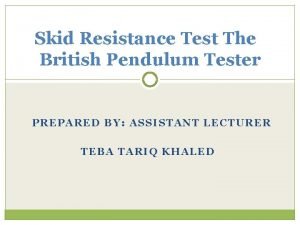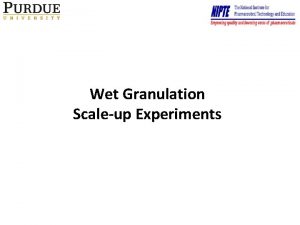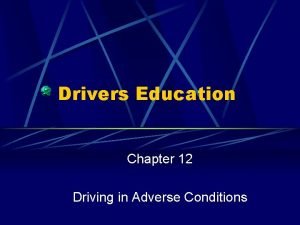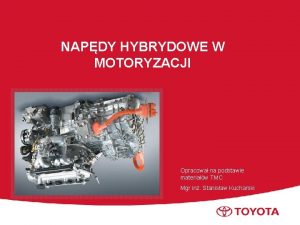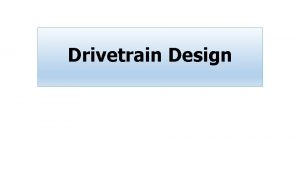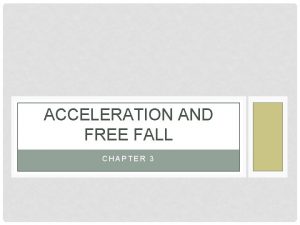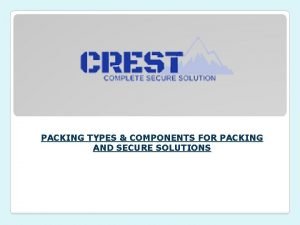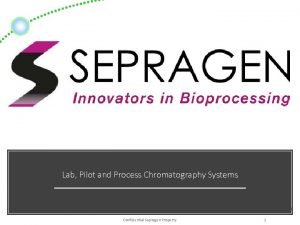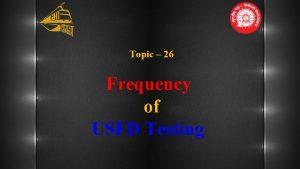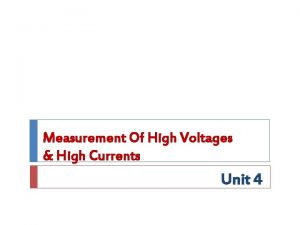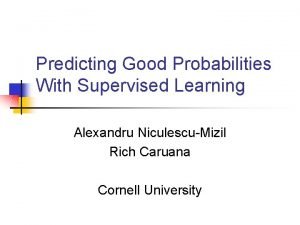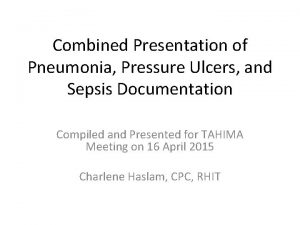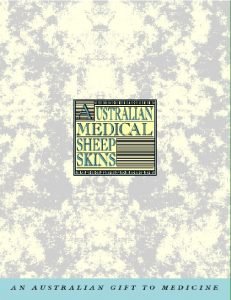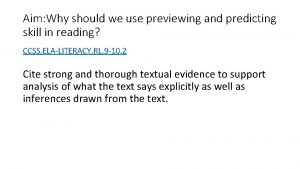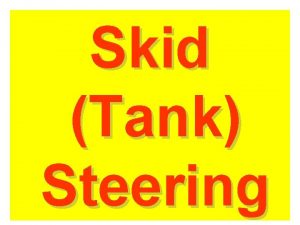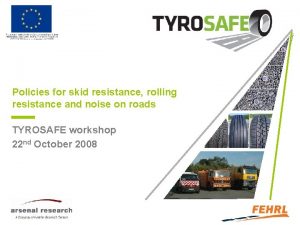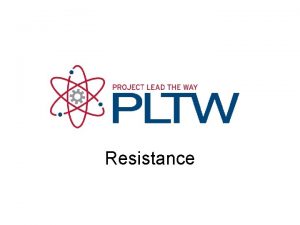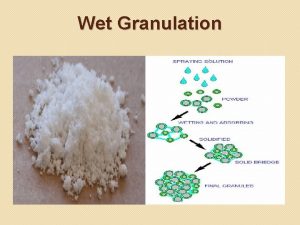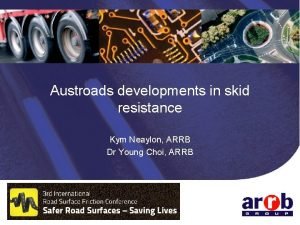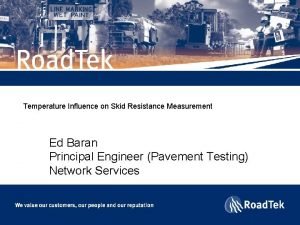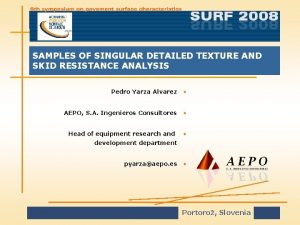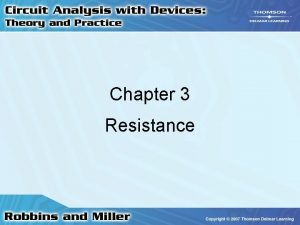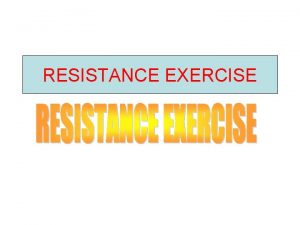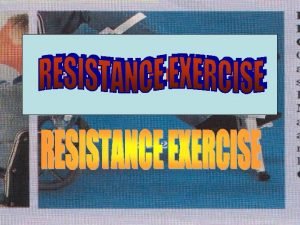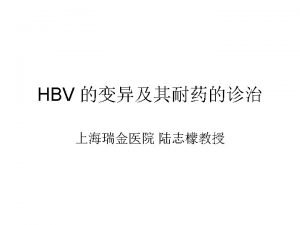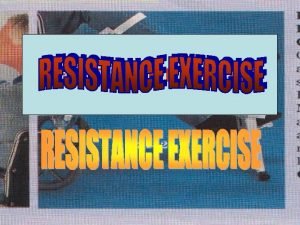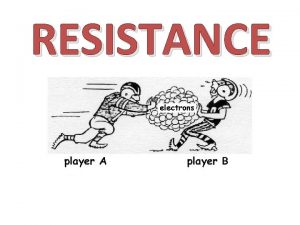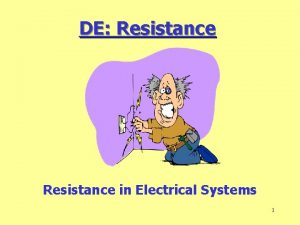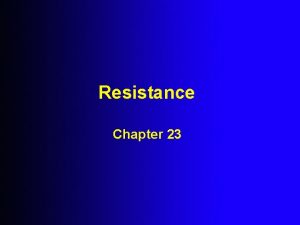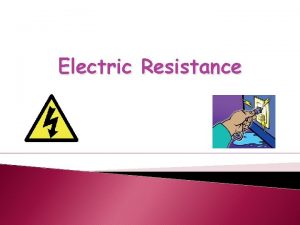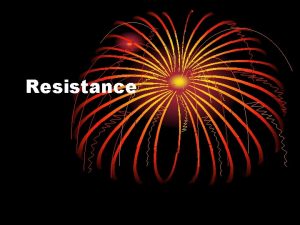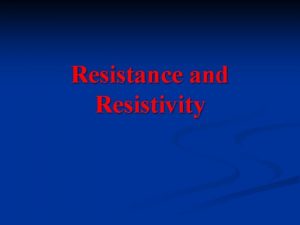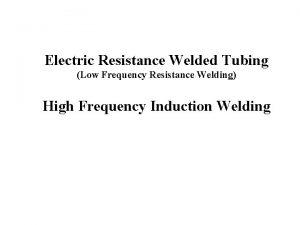HIGH FREQUENCY TESTING FOR PREDICTING WET SKID RESISTANCE






























- Slides: 30

HIGH FREQUENCY TESTING FOR PREDICTING WET SKID RESISTANCE A. RATHI 1, M. HERNÁNDEZ 2, S. J. GARCÍA 2, C. BERGMANN 3, J. TRIMBACH 3, J. W. M. NOORDERMEER 1, W. K. DIERKES 1, A. BLUME 1 1 DEPARTMENT OF ELASTOMER TECHNOLOGY AND ENGINEERING, UNIVERSITY OF TWENTE, ENSCHEDE, THE NETHERLANDS 2 NOVEL AEROSPACE MATERIALS, FACULTY OF AEROSPACE ENGINEERING, DELFT UNIVERSITY OF TECHNOLOGY, DELFT, THE NETHERLANDS 3 HANSEN & ROSENTHAL KG, HAMBURG, GERMANY

2 GOAL To find the best ratio of S-SBR / BR blends and the best oil for optimal tire tread performance: • S-SBR / BR Blend wt. ratios : 100 / 0 ; 90 / 10 ; 80 / 20 ; 70 / 30; 60 / 40 • Oils : • Mineral-based oil : Treated Distillate Aromatic Extract (TDAE) • Polar bio-based oil : Vivamax 5000 1

3 FORMULATION COMPONENT S-SBR BR Silica (ULTRASIL 7000) Silane (TESPT) Oil (TDAE / Vivamax 5000) Zn. O Stearic Acid Sulphur CBS DPG AMOUNT (in phr) 100 / 90 / 80 / 70 / 60 0 / 10 /20 / 30 / 40 90 7. 9 30 2 1 1. 4 2 2 2

4 PERFORMANCE INDICATORS ABRASION RESISTANCE (AR) DIN Abrader ROLLING RESISTANCE (RR) Dynamic Mechanical Analysis (DMA) WET SKID RESISTANCE (WSR) DMA Broadband Dielectric Spectroscopy (BDS) 3

5 ABRASION RESISTANCE (AR) DIN ABRADER : Quantified in terms of weight loss during the abrasion test 4

6 ABRASION RESISTANCE (AR) DIN-AR : • Increasing wt. ratio of BR gives better AR • Vivamax 5000 gives better AR than TDAE 5

7 AR WITH DIN ABRADER • Lowest DIN-AR : S-SBR / BR 60 / 40 with Vivamax 5000 • Reason: The lower the Tg, the better is the AR. Tg (Tg of BR = -100 °C) -> AR % BR -> AR 6

8 ROLLING RESISTANCE (RR) DMA : Temperature sweep at 1 Hz tan δ at 60 °C 7

9 ROLLING RESISTANCE (RR) DMA : Blend with 0 – 20 % BR and Vivamax 5000 have lowest RR. 8

1 0 RR WITH DMA AND RPA • Lowest RR (DMA) : S-SBR / BR 100 / 0 ; 90 / 10 ; 80 / 20 with Vivamax 5000 • Reason : DMA : Vivamax 5000 leads to better compatibility within the blend, addition of 10 % BR further lowers the RR. 9

WET SKID RESISTANCE (WSR) DMA: Tan δ at 0 °C / 1 Hz as a WSR indicator. 10

WET SKID RESISTANCE (WSR) DMA : • Increasing amount of BR, decreases the tan δ. • Negligible effect of the oils, although better WSR is expected with Vivamax 5000. 11

1 3 WSR WITH DMA • Highest WSR : S-SBR / BR 100 / 0 with Vivamax 5000 • Reason : S-SBR has higher Tg than BR. Tan δ at 0 °C -> WSR. LIMITATION !!!! • Negligible effect of the type of oils although better WSR is expected with Vivamax 5000. • But : tan δ at 0 °C is a bad indicator of WSR, often NO correlation to tire tests. 12

1 4 BASICS OF WSR Rahalkar, R. R. , RCT 62, 1989. Due to the apparent friction acting on a skidding tire – HIGH FREQUENCY PHENOMENON (103 to 106 Hz)! 13

HIGH FREQUENCY TESTING WITH BDS • Measured at a range of -120 to 80 °C and 106 to 10 -1 Hz. • Progression of Tg over the measured range of temperature and frequency. Tg of b len d Tg o f cis -bu tad ien e S-SBR / BR 60 / 40 blend 14

1 6 WSR WITH BDS : ε“ / ε“MAX at 60 °C / 106 Hz as BDS WSR indicator 15

1 7 WSR WITH BDS : • Better WSR of compounds with Vivamax 5000 compared to the TDAE counterparts. 16

1 8 WSR WITH BDS • Highest WSR : S-SBR / BR 100 / 0 with Vivamax 5000 • Reason : Highest Tg at Room Temperature (R. T. ) Better compatibility with Vivamax 5000 Maximized hysteresis at 60 °C / 106 Hz 17

INTERACTION OF OILS WITH S-SBR & BR S-SBR δ = 17. 3 MPa 0. 5 BR δ = 17. 2 MPa 0. 5 TDAE δ = 17. 2 MPa 0. 5 VIVAMAX 5000 δ = 17. 7 MPa 0. 5 δ is calculated according to group contributions method Δδ = δS-SBR / BR – δTDAE / Vivamax 5000 • Plasticization of S-SBR (Δδ = 0. 1) • Stiffening of BR (Δδ = 0) • Leads to less homogeneity in the blend. • Plasticization of S-SBR (Δδ = 0. 4) • Plasticization of BR (Δδ = 0. 5) • Leads to more homogeneity in the blend 18

S-SBR / BR 60 / 40 with TDAE / VIVAMAX 5000 • Less homogeneity • Clear cis-butadiene segments peak at high frequencies Tg of blend • More homogeneity • Not so clear cis-butadiene segments at high frequencies Tg of blend Tg of cis-butadiene • Clear 2 peaks • Less homogeneity • 1 broad peak • More homogeneity 19

2 1 GOAL CONCLUSION To find the best ratio of S-SBR / BR blends and the best oil for optimal tire tread performance: • SSBR / BR Blend wt. ratios : 100 / 0 ; 90 / 10 ; 80 / 20 ; 70 / 30; 60 / 40 • Oils : • Mineral-based oil : Treated Distillate Aromatic Extract (TDAE) • Polar bio-based oil : Vivamax 5000 20

2 2 CONCLUSION S-SBR / wt. ratio AR -Wt. loss / mm 3 RR -Tan δ at 60 °C / 1 Hz WSR -Tan δ at 0 °C / 1 Hz -ε“/ε“max at 1 MHz / 60 °C 100 / 0 90 / 10 80 / 20 70 / 30 60 / 40 21

2 3 CONCLUSION TYPES OF OIL AR -Wt. loss / mm 3 RR -Tan δ at 60 °C / 1 Hz WSR -Tan δ at 0 °C / 1 Hz -ε“/ε“max at 60 °C / 1 MHz VIVAMAX 5000 -Higher polarity oil TDAE -Lower polarity oil 22

2 4 BEST BALANCE OF PROPERTIES S-SBR / wt. ratio AR -Wt. loss / mm 3 RR -Tan δ at 60 °C TOTAL WSR -Tan max δ atat 01°CMHz / 60 °C -ε“/ε“max at 1 MHz / 60 °C 100 / 0 3. 9 3 / 65 mm 3 = 1. 8 117 mm 1. 1 1. 8 1. 0 / 1. 0 90 / 10 3. 6 104 mm 1. 63 / 65 mm 3 = 1. 6 1. 0 0. 8 / 1. 0 80 / 20 3. 7 3 / 65 mm 3 = 1. 5 94 mm 1. 5 1. 1 0. 6 / 0. 9 70 / 30 3. 4 3 / 65 mm 3 = 1. 2 76 mm 1. 2 1. 1 0. 6 / 0. 9 60 / 40 3. 4 3 / 65 mm 3 = 1. 0 65 mm 1. 0 1. 2 0. 5 / 0. 8 23

2 5 BEST BALANCE OF PROPERTIES Best trade-off in the AR, RR and WSR is obtained for: S-SBR / BR 70 / 30 blend with Vivamax 5000 AR (DIN Abrader) RR (Tan δ at 60 °C ) WSR (Tan δ at 0 °C / ε“/ε“max at 1 MHz / 60 °C) 76 mm 3 0. 12 0. 29 / 0. 83 24

ACKNOWLEDGEMENTS • H&R Ölwerke Schindler Gmb. H (Hamburg, Germany) for the scientific, financial and materials support as well as the permission to present this work. • Dr. Marianella Hernández and Dr. Santiago Garcia for the support with dielectric measurements. • Prof. Anke Blume, Prof. Jacques Noordermeer, Andries van Swaaij and the colleagues at the ETE group.

THANK YOU!

CORRELATION PLOT DMA AT 1 HZ VS. BDS AT 90 HZ *calculated with frequency lag for S-SBR 100 28

HOW ARE THE RESULTS AFFECTED? DMA : Frequency sweeps from 0. 1 to 100 Hz at temperatures from 30 to -80 °C in steps of 5 °C used for TTS. BDS : Measured at a range of -100 to 80 °C and 106 to 10 -1 Hz. Same temperature dependence with a frequency lag ~ 90 -100 Hz for DMA. 29

3 0 IDEAL TIRE TREAD COMPOUND FOR WSR Tread rubber must have : higher Tg at ambient temperature and 103 to 106 Hz frequency to ensure • Maximum hysteresis • Reversible phase change to the glassy state
 British pendulum tester
British pendulum tester Wet wet wet
Wet wet wet Driving in adverse conditions
Driving in adverse conditions Skid meaning in driving
Skid meaning in driving Pre crash safety toyota
Pre crash safety toyota Robot drivetrain types
Robot drivetrain types In coming to a stop a car leaves skid
In coming to a stop a car leaves skid Crest lashing and packaging private limited
Crest lashing and packaging private limited Sepragen corporation
Sepragen corporation Protech anti skid floor agent
Protech anti skid floor agent Vex drivetrain
Vex drivetrain Specific resistance formula
Specific resistance formula What is a force that opposes motion through direct contact
What is a force that opposes motion through direct contact What is conditional relative frequency
What is conditional relative frequency Observed frequency
Observed frequency Angular frequency to frequency
Angular frequency to frequency Vmax= aw
Vmax= aw Relative frequency bar chart
Relative frequency bar chart What is a marginal frequency
What is a marginal frequency Joint relative frequency
Joint relative frequency Usfd testing frequency
Usfd testing frequency Generating voltmeter
Generating voltmeter Predicting products of chemical reactions
Predicting products of chemical reactions Predicting products of chemical reactions
Predicting products of chemical reactions More predicting products of chemical reactions
More predicting products of chemical reactions Predicting good probabilities with supervised learning
Predicting good probabilities with supervised learning Combination reaction equation
Combination reaction equation Braden score meaning
Braden score meaning Bahasa inggris disusun
Bahasa inggris disusun Braden scale for predicting pressure sore risk
Braden scale for predicting pressure sore risk Apa itu previewing and predicting
Apa itu previewing and predicting
